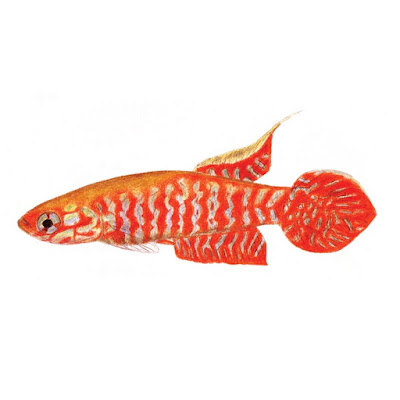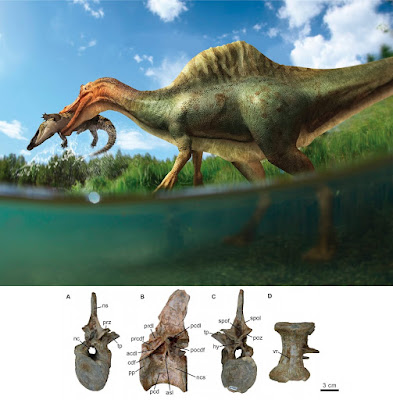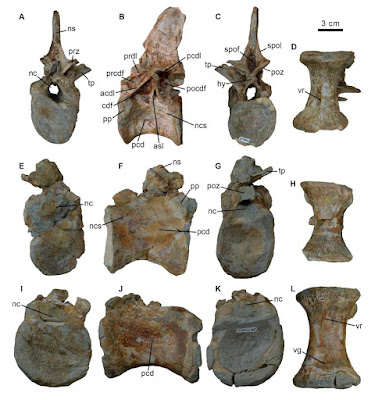[Most Recent Entries] [Calendar View]
Thursday, August 22nd, 2019
| Time | Event | ||||||
| 6:06a | [Ichthyology • 2019] Leptopanchax sanguineus • A New Species of Cynopoeciline Killifish (Cyprinodontiformes, Aplocheilidae), possibly Extinct, from the Atlantic Forest of south-eastern Brazil Abstract Specimens found between 1985 and 1988 in the Magé River Basin, south-eastern Brazil were misidentified as L. splendens. The recent rediscovery of other specimens in the Estrela River Basin near the type locality of L. splendens has clarified the species’ concept, making it possible to recognise the Magé River Basin specimens as a new species. The new species is herein described as Leptopanchax sanguineus sp. nov. and is distinguished from all other cynopoecilines by a unique colour pattern in males, including red bars with sinuous margins. It was collected in a well-preserved, temporary shallow swampy area within dense moist forest, but since 1990 the species has not been found again. Leptopanchax sanguineus sp. nov. is one of three species of cynopoeciline killifishes living in lowland moist forests of the coastal plains of Rio de Janeiro State, where the greatest diversity of endemic cynopoecilines is concentrated. Each of these species has been recorded a single time in the last 30 years, a surprisingly low record attributable to intense deforestation during the last several decades resulting in small fragmented lowland moist forests of today. This study indicates that seasonal killifishes adapted to uniquely live in this kind of habitat should be regarded with special concern in studies evaluating conservation priorities. Keywords: Biodiversity, conservation, moist tropical forest, systematics, taxonomy Leptopanchax sanguineus sp. nov. Diagnosis: Leptopanchax sanguineus differs from other cynopoecilines, except L. splendens, by the presence of red bars on the whole flank in males (vs. absence); uniquely in L. sanguineus, the bars are broad, wider than the interspace width (vs. narrow, half interspace width or less) and have sinuous margins (vs. straight). Leptopanchax sanguineus is further distinguished from L. splendens by having 15 dorsal-fin rays (vs. 12–14), 6 pelvic-fin rays (vs. 5), 27 scales on the longitudinal series and 9 on the transverse series (vs. 24–25 and 7, respectively), 29 vertebrae (vs. 26–27), pelvic fin tip posteriorly reaching the anal fin in males (vs. reaching urogenital papilla), pelvic-fin bases medially separated, in close proximity (vs. medially united), absence of filamentous rays on the caudal fin (vs. short filamentous rays on the posterior margin of the caudal fin in males), presence of a golden stripe on the distal margin of the dorsal fin in males (vs. white stripe), absence of contact organs on the male pectoral fin (vs. presence) and absence of the dermosphenotic bone (vs. presence). Leptopanchax sanguineus also differs from L. splendens and all other cynopoecilines by the presence of a small red spot on the posterior portion of the iris (vs. spot absent). Etymology: The name sanguineus, from the Latin, meaning blood-coloured, is an allusion to the predominantly red colouration in males, unique among Neotropical killifishes.
Wilson J. E. M. Costa. 2019. Description of A New Species of Cynopoeciline Killifish (Cyprinodontiformes, Aplocheilidae), possibly Extinct, from the Atlantic Forest of south-eastern Brazil. ZooKeys. 867: 73-85. DOI: 10.3897/zookeys.867.34034 Abstract: A recent collection of the seasonal killifish found Leptopanchax splendens c. 5 km from the type locality, 74 years after its last record. The species was historically common in its type locality, the Estrela River basin in south‐eastern Brazil, until 1950, after which it was not encountered and thought to have become extinct due to widespread deforestation and urbanization in the region. Despite the rediscovery, this study finds that other recently published reports of L. splendens are misidentifications. Wilson J. E. M. Costa, José L. O. Mattos and Pedro F. Amorim. 2019. Rediscovery of Leptopanchax splendens (Cyprinodontiformes: Aplocheilidae): A Seasonal killifish from the Atlantic Forest of south‐eastern Brazil that was recently considered extinct. Journal of Fish Biology. DOI: 10.1111/jfb.13898 | ||||||
| 1:41p | [Paleontology • 2019] Vallibonavenatrix cani • A New Spinosaurid Theropod (Dinosauria: Megalosauroidea) from the late Barremian of Vallibona, Spain: Implications for Spinosaurid Diversity in the Early Cretaceous of the Iberian Peninsula
Abstract A new medium-sized theropod dinosaur from the Arcillas de Morella Formation (upper Barremian) in Vallibona (Castellón, Spain) is described based on a partial skeleton. Vallibonavenatrix cani, gen. et sp. nov., is diagnosed by five autapomorphies: moderately high dorsal neural spines relative to the centrum height, the presence of deep pleurocoelous fossae and pneumatic foramina in the sacral vertebrae, a strongly pneumatic ilium with large internal cameras, the presence of a broad and flat platform on the ventromedial surface of the postacetabular blade of the ilium, and the strong ventral torsion of the ischium diaphysis. Phylogenetic analysis recovered Vallibonavenatrix cani as a spinosaurid megalosauroid and revealed that the new Iberian form is more closely related to Gondwanan spinosaurines, such as Spinosaurus, Irritator or Angaturama and the Asian taxon Ichthyovenator than it is to its synchronic contemporary European taxon Baryonyx walkeri. The Gondwanan or Asian affinities of Vallibonavenatrix indicate a complex palaeobiogeographic pattern and may be interpreted simultaneously as evidence for contact between Europe and North Africa and between Europe and Asia before the Aptian. This specimen is currently the most complete evidence of a spinosaurid theropod known in the fossil record of the Iberian Peninsula. Keywords: Vallibonavenatrix, Spinosauridae, Early Cretaceous, Iberian Peninsula, Arcillas de Morella Formation
Systematic Paleontology Dinosauria Owen, 1842. Theropoda Marsh, 1881. Megalosauroidea (Fitzinger, 1843) Spinosauridae Stromer, 1915. Vallibonavenatrix gen. nov. Etymology. Vallibona-, as the town where the holotype specimen was found, and -venatrix, as the Latin for huntress. Vallibonavenatrix cani sp. nov. Etymology. The species epithet honours Juan Cano Forner, who found the holotype specimen. Type locality and type horizon. The specimen was collected in the locality of Santa Águeda, near the town of Vallibona (Castellón province, Spain). The sediments that contained the fossils belong to the Arcillas de Morella Fm., late Barremian in age (Bover-Arnal et al., 2016). .... Elisabete Malafaia, José Miguel Gasulla, Fernando Escaso, Iván Narváez, José Luis Sanz and Francisco Ortega. 2019. A New Spinosaurid Theropod (Dinosauria: Megalosauroidea) from the late Barremian of Vallibona, Spain: Implications for Spinosaurid Diversity in the Early Cretaceous of the Iberian Peninsula. Cretaceous Research. In Press. DOI: 10.1016/j.cretres.2019.104221 #Vallibonavenatrix #dinossáurio #terópode #espinossaurídeo #Cretácico #Castellón |
| << Previous Day |
2019/08/22 [Calendar] |
Next Day >> |









